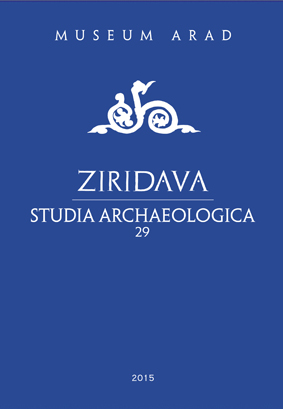Items Discovered during the 1983 Campaign in the
Workshop no. 3 from the Fortification of Cladova
(Comm. of Paulis, Arad County)
Items Discovered during the 1983 Campaign in the
Workshop no. 3 from the Fortification of Cladova
(Comm. of Paulis, Arad County)
Author(s): Silviu Oţa, Liana Oţa, Gheorghe NiculescuSubject(s): Archaeology
Published by: Editura Mega Print SRL
Keywords: workshop; fortification; weapons; utensils; jewelry
Summary/Abstract: The fortification of Cladova, located east of the mouth where creek Cladova flows into RiverMureş, stands on top of a hill (Pl. 1). Research there started during the 1970s, coordinated by Vasile Boroneanţ.The fortification was built upon an older, Dacian one, made of wood and earth. Inside the medieval structurearchaeologists have discovered several medieval workshops, a hall-type stone church (with a semicircular altarand a narthex) and two overlapping necropolises (Pl. 2). Inside the fortification, workshops no. 3 was locatedapproximately 10 m north of the church (discovered in the southern half of the fortification). It was irregularin shape, with the short sides measuring 3.90 and 4.10 m and the long size measuring 5.30 and 5.40 m respectively.The workshop was dug into the soil (- 1.2 m) and partially into the rock (–0.65 m) as compared to thepresent-day ground level. The complex was dated through pottery, one silver ring (Pl. 5/7), and one coin issuedduring the reign of Bernhard II of Carinthia (1202–1254). The metal-made inventory of the dwelling/workshopis extremely diverse and one must differentiate among entire items, used by the master while the workshop wasin use, and items gathered and stored there in order to be reprocessed, as primary material (Pl. 3–10). It is ratherdifficult to say which were end products for personal use and which were objects made on demand, to be sold, orfor the benefit of those living inside the fortification. One can also add jewelry items and dress accessories, sometypically worn by women (Pl. 5/8, 9, 12).Among the items found inside the complex, the spindle whorl, beads, hair ring, and the awl suggest it wasa dwelling-workshop used not only the master, but also by a girl or a woman.Taking all these elements into consideration, one can state that the complex under discussion served adouble purpose, as both dwelling and workshop. The metal material discovered inside it suggests the fact thatiron was mainly processed there, beside copper and bronze. The items recovered from this complex, thoughit remains unclear if only used by those inside the fortification, were presumably recovered from the area ofCladova and were part of artifacts used in that area during the first half of the 13th century. Other several itemsare earlier, as, for example, the fragment of a knife with guard (Pl. 4/7).Though it is obvious that at least some of the masters from the fortifications recovered or purchase brokenor old, discarded objects, we believe it is interesting to note that after the workshop was abandoned no onereturned to gather the metal left behind there. The fortification, we can assume, remained uninhabited for awhile and those who returned only did so after a relatively long period. The inhabitants of the workshop mostprobably never returned, out of various reasons that one can at most guess and that were due to the Tatarinvasion of 1240–1241.
Journal: Ziridava. Studia Archaeologica
- Issue Year: 29/2015
- Issue No: 1
- Page Range: 347-374
- Page Count: 27
- Language: English

